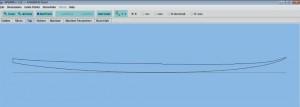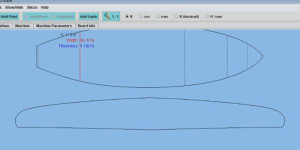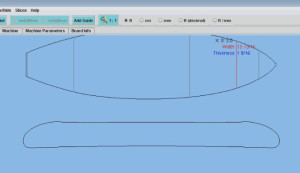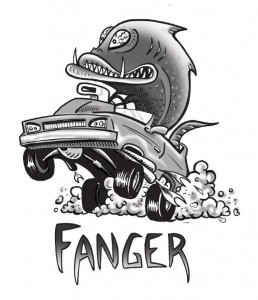Perhaps the ugliest board I have designed thus far, but the way this thing goes you could liken it to one of those hell bodies that need a paper bag over its head. Sometimes there are ideas that you have where function overules aesthetics and with the Fanger this was certainly the case.
I have been working on this left of centre design over the past 5 years and have made numerous versions. It was a struggle to design because of the slice variation at either end and I have had to go a little more subtle in order to smooth the bumps from the rail shoulder line

I can say that after all the testing and tweeking it is now ready for offering as one of my models. The last prototype of the Fanger taken up by Ralf Faint of Lennox as part of my R&D Aliance Program helped with the final touches.
 The concept is to have a really thick tail that bights. The benefit of this is that you can keep running regardless of how deep you bury the tail. Tails that are too thin are easy to bury and pivot but they stay buried for too long and simply do not run. A tail which is too thick on the stringer more often than not will be too thick on the rail and be difficult to bight and hold. So the objective for this design was to have thickness in the tail on the stringer but not on the rail.
The concept is to have a really thick tail that bights. The benefit of this is that you can keep running regardless of how deep you bury the tail. Tails that are too thin are easy to bury and pivot but they stay buried for too long and simply do not run. A tail which is too thick on the stringer more often than not will be too thick on the rail and be difficult to bight and hold. So the objective for this design was to have thickness in the tail on the stringer but not on the rail.
 The design has a heavy vee into the bottom in the tail area as well as a heavy rolled vee on the deck in the same area. Both these vees squeeze the thickness out of the rail and make it easy to engage and bury. Having too thin a rail all the way through to the nose would make the rail bury too easy and make the board to sensitive so I have done the opposite to the rail slice up front. That is, made both the deck and the bottom heavily concaved on the nose slice, which squeezes all the thickness out to the rails in that area.
The design has a heavy vee into the bottom in the tail area as well as a heavy rolled vee on the deck in the same area. Both these vees squeeze the thickness out of the rail and make it easy to engage and bury. Having too thin a rail all the way through to the nose would make the rail bury too easy and make the board to sensitive so I have done the opposite to the rail slice up front. That is, made both the deck and the bottom heavily concaved on the nose slice, which squeezes all the thickness out to the rails in that area.
This radical slice would make the rails way too thick up front if I was to keep the stringer profile the same thickness as normal boards on the nose, so the nose profile has to be reduced right down in thickness to keep the rail thickness in check. Effectively this keeps the front half from feeling too front heavy, although it may seem it is if you were to judge by the rail thickness forward of centre.
This board looks and feels front heavy, but volume wise it is not. Having a very buriable back half is countered by having a resisting thicker rail forward of centre which in essence allows one to sink the tail rail and drive off the thicker rail forward not to mention the forgiveness that extra foam forward gives to a surfer that pins his heart on his front foot.
And all the time the board just keeps on running regardless because of all that rear thickness just lifts up and pushes forward.
Firstly I designed this as primarily a quad but by pulling the tail in a little more I have made it perform pretty good as a thruster also. Remembering that with this radical new design the tail rail is so thin that it automatically relieves pressure off the rear centre fin.
The thruster rear fin’s job it is to secure the tail rail to the face so as not to slide out when pressured through turns and when the rail buries easily the less loading there is on that fin. This is why even though the tail is widish for a thruster it is flying and holding to the face in waves bigger that it is meant to.

As I have said, I have made quite a few of these experimental boards and the feedback has been really good. Because the board looks a little weird it may take a wave of testimonials to have people believe that this rail warped concoction has merit.
One of its believers (Kenafakes) demanded the right to name it, and he came up with “The Fanger” …. so be it!
5.8 x 19 ½ x 2 3/16
5.10 x 19 ¾ x 2 1/4
6.0 x 20 x 2 5/16
6.2 x 20 ¼ x 2 3/8
6.4 x 20 ½ x 2 7/16
——————————————————
Lots to say. I love it.
Top of the list is its incredible versatility. Its crap when you hear people say certain boards work in an extensive range of size and conditions but the simple fact is they don’t and the Fang does. I have ridden it in everything from full gutless one foot Main beach to Solid hollow 4 to 6 ft straddie.
In small crap it is super responsive, very quick to change direction and recover and easy to accelerate. It also has the ability to glide over fat sections if you know how to take advantage of the wide nose.
As soon as the size increases and a bit of lip appears then you really see how the tail comes into play along with the front rail (warpy bit). You don’t have to be gentle with it because the wide nose wants to make you nurse your turn, you can lean into it full on, get your turn started and know that the tail is going to take care of business no matter how steep, critical, hollow or fast you a are going.
Whilst most fat nose boards are problematic in hollow straddie this guy seems to be unaffected, the concave under the nose and the back rail section let you get high in the tube, hold a line and go flat out. Apart from all this it seems to paddle just as good as any other similar length, style board i have ridden. As for fins, can’t comment on four, but three (with a keel) is Fang heaven.
Kenafakes
——————————————————————————–
Hi Muzz
I proudly made a quick answer regarding the Fanger .
First of all this one is maybe or surely one of my 5 best boards I ever had ! .. most notorious points are :
Very easy and comfortable in paddling , excellent transition rail to rail, a continued acceleration and speed even in poor power waves.
Finally a very close radical of a shortboard !
But the most remarkable is this one keep a maximum of drive in any circumstances down the line, and offer a surprising fluidity !
The hook of the rails is excellent and his commitment in short arc turns is radical and incredible.
This model will be for sure a great success and must be continued !
Chris Polony
———————————————-
Hi Muzza,
I launched the 6″3′ Fanger set up as a quad at Snapper today. I took a couple of waves to get used to the feeling of the board but once I did I loved it. It’s very manoeuvrable and responsive and easy to go vertical on especially for a quad.
Because of the thinness of the rail near the tail it has heaps of bite and feels very direct coming off the bottom, more so than the round tail quads I have been riding. As with all quads you have made me it flies.
I think you were definitely right about not going to thick as the rails at the front of the board would blow out and make it feel to boatie, 2 3/8ths was perfect for me, even though I dropped about 1 litre or so in volume the board is easy to paddle. You have been making me boards for 20 years and it amazes me how you continue to come up with so many different designs that work.
Thanks again mate,
Glen.

